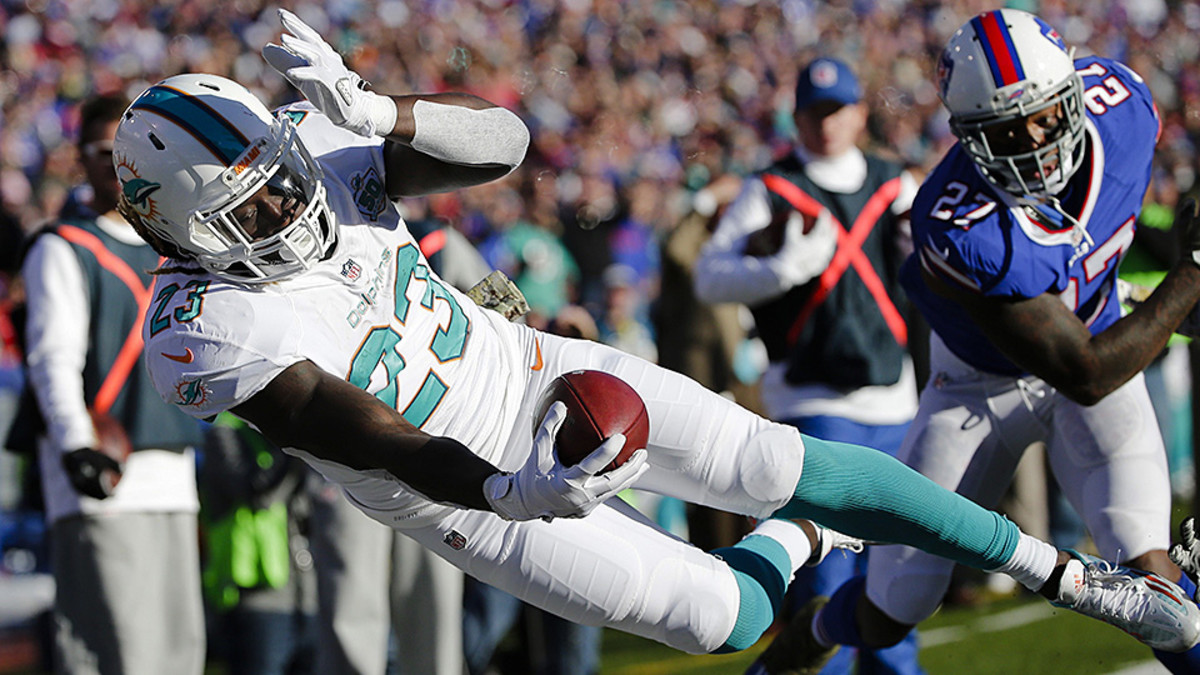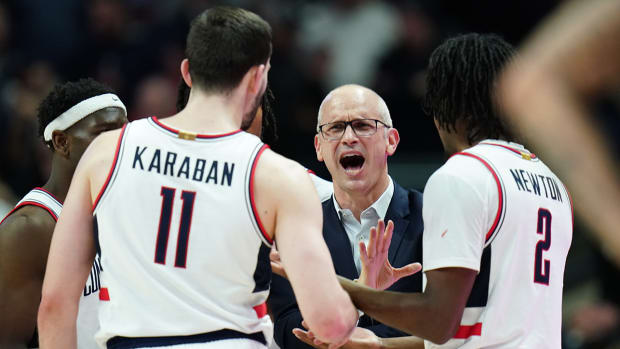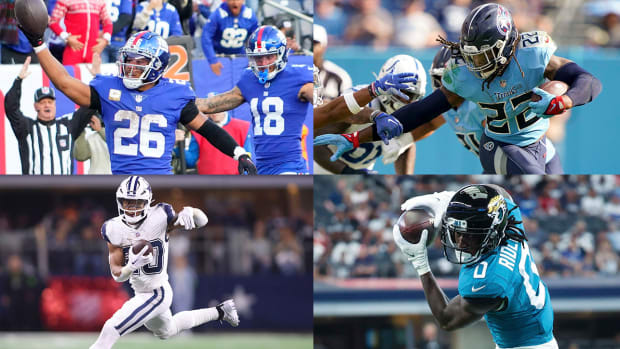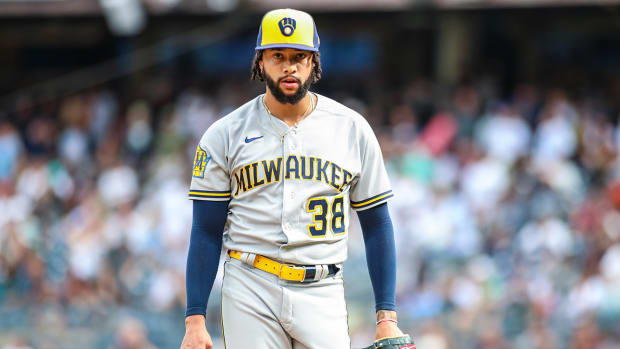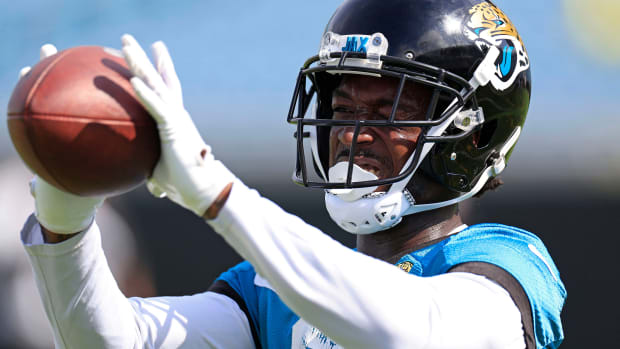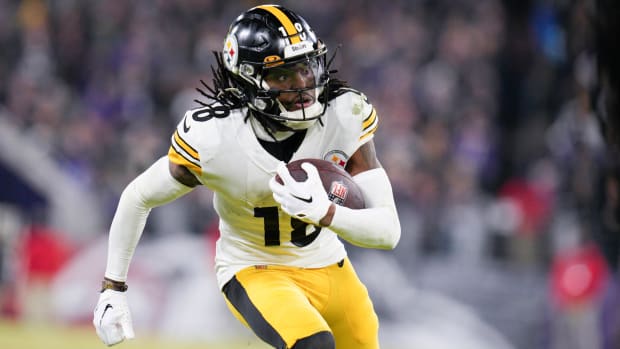Dolphins running backs? A Matt Ryan bounceback? Fantasy experts debate
Your teams. Your favorite writers. Wherever you want them. Personalize SI with our new App. Install on iOS or Android.
Every Friday until the end of fantasy draft season, SI.com fantasy football experts Michael Beller and Pat Fitzmaurice will bat around a number of questions in a quest to help you assemble the best fantasy team possible.
What’s your take on the Miami backfield after the Arian Foster signing?
Beller: This has all the elements of a stay-away for me. There are some backfields not worth the headache, no matter the apparent upside. A good recent example is Washington last season, where Matt Jones and Alfred Morris traded primacy back and forth seemingly every week, and they finished as RB40 and RB45, respectively. I don’t think the Foster and Jay Ajayi pairing will be that bad, but I do think it will be hard to figure out from week to week and nearly impossible to project during draft season. That’s just not a situation on which I want to spend a draft pick.
The mere signing of Foster is an indictment of Ajayi. No matter what Foster has done in his career to this point, he’s a 30-year-old injury-prone running back coming off a ruptured Achilles. New Miami head coach Adam Gase hinted earlier in the summer that he was dissatisfied with Ajayi’s performance in pass protection, a deficiency that likely hastened the Foster signing. Foster has long been a capable receiver out of the backfield, and that same skill was one of the real drivers of Ajayi’s upside this season, especially in an offense designed by Gase. It’s hard to imagine Ajayi racking up enough targets to make a statistically significant impact as a receiver.
While we have to assume Foster will be in the starter’s chair for the time being, the list of 30-year-old running backs who have made successful returns after rupturing their Achilles is blank. In fact, I suppose we can’t call it a list, because, by its definition, a list needs at least two entries. Foster managed just four games before his Achilles injury last year, and while he averaged 13.8 points per game in standard-scoring leagues, he did nearly all his damage as a receiver. Foster ran for 163 yards on 63 carries while healthy last season.
It’s possible Foster will stay healthy and give the fantasy community an RB2 season. It’s possible Ajayi will prove he’s the better option at this stage of their respective careers and turn Foster into a glorified backup. Neither of those is an outcome on which I want to bet.
Fitz: The Dolphins were trying to tell us they didn’t trust Jay Ajayi. They gave an offer sheet to C.J. Anderson that Denver chose to match. They spent a draft pick on a running back, Alabama’s Kenyan Drake. And finally, they signed Foster, whom they’d approached earlier.
Some people are speculating that Foster will be used mostly on passing downs and Ajayi will get most of the carries. I’m not sure I’d buy that even it came straight from the Dolphins. Ignore the fact that Foster averaged 2.6 yards per carry last year—the sample size was too small to be meaningful. When healthy he’s still a better back than Ajayi. But of course, Foster won’t stay healthy, which makes him a gamble any time before the sixth or seventh round of a 12-team fantasy draft.
As Ajayi’s ADP tumbles in the weeks to come, it will fall to the point where he’ll be touted by some as a bargain. Thing is, can you imagine yourself plugging Ajayi into your lineup in any week when Foster is active? I don’t think he’ll be usable unless Foster goes down. And should Foster somehow stay intact deep into the season, Ajayi investors will have rolled snake eyes.
• Fantasy profiles: Brees | Bernard | Barnidge | Decker | Gordon
Who’s the QB2 you’ve got your eye on in superflex leagues?
Beller: Fitz and I recently discussed offline how you could pretty much put the names of the quarterbacks ranked 13th through 24th in a hat, pull them out in a random order, and have as good a chance of nailing the way they’ll finish as anyone else. Tyrod Taylor would have been my answer to this question a month ago, but I’m starting to get nervous about an offense that is going to have to play relatively slow to win games. I like Kirk Cousins, Andy Dalton and Derek Carr, but I’m not sure there’s a ton of profit potential for those three at their average draft positions in superflex leagues. So how about old friend Matt Ryan?
It’s not an exaggeration to say that, from the perspective of draft-day value, Ryan was the worst quarterback in the league last season. After fantasy owners made him the eighth quarterback off the board in a typical draft, he finished the year 19th in total points and 28th in points per game, behind Josh McCown, Brian Hoyer and Blaine Gabbert, a downfall made all the more unlikely considering he had the No. 2 receiver (Julio Jones) and No. 1 running back (Devonta Freeman) at his disposal. Still, he wasn’t that much different than the quarterback he was in 2011 through ’14, seasons in which he was QB8, QB7, QB12 and QB7. Across those four years, he completed 66% of his passes for an average of 4,526.25 yards per season and 7.36 yards per attempt. Last year, he connected on 66.3% of his passes for 4,591 yards and 7.48 YPA.
The difference came in the touchdown and interception departments. From ’11 through ’14, Ryan averaged 28.75 touchdowns and 14.25 interceptions per season. He threw 21 scores—his lowest total since his rookie year—against 16 picks last year. I’m ready to believe that was fluke, especially since I don’t have to pay too much for Ryan. I also like betting on the guy who will have Jones on the opposite end of 200 or so of his pass attempts. Ryan has low-end QB1 upside, and you barely have to pay a QB2 price tag to get him.
Fitz: I’ll parrot Beller on this one. Matt Ryan was overrated for a long time, and now, after an uncharacteristic hiccup in his TD numbers, the pendulum has swung against him and his ADP has tumbled into the mid-QB2 range.
Ryan’s TD rate was a career-low 3.4% last year. His other numbers—completion percentage, passing yardage, yardage per attempt—were all in line with career norms. We’re talking about a guy who’s averaged better than 4,600 passing yards over the last four seasons. He’s thrown for at least 250 yards in 27 of his last 34 games, and the last time he failed to throw for at least 200 yards in a game was November of 2013. He still has Julio Jones, and while newly acquired receiver Mohamed Sanu has been belittled in some quarters, he’s nevertheless an upgrade over the ghost of Roddy White.
I’ve done my share of Ryan-bashing in the past, but I rate Matty Ice a strong buy at his deflated ADP.
• Fantasy position rankings: Top 10 QBs | RBs | WRs
If you could give one player a new home, who would it be and why?
Beller: I owned Demaryius Thomas in as many leagues as possible in 2013, when he had 92 catches for 1,430 yards and 14 touchdowns. That was also the season in which the NFL debuted their fantasy commercial where Thomas taught us all that “only winners get wings.” I had a lot of metaphorical wings that season, and Thomas has been one of my favorite fantasy players ever since. Unfortunately, he’s stuck on a team that will be starting Mark Sanchez or Trevor Siemian this season. That’s a far cry from the Peyton Manning of 2012 through ’14. Thomas’s consensus ranking over at FantasyPros places him 16th among receivers, but no one would tell you there are 15 receivers in the league with more talent than Thomas. There might not even be four or five. Thomas, however, could find himself in one of the worst passing environments in the league this season, and no player can divorce himself entirely from the context in which he plays. If Thomas could trade places with someone like A.J. Green or Jordy Nelson, he’d be an easy top-five receiver. As it stands, he’s not even being drafted as a WR1. As bad as the Denver quarterback situation might be, that could make Thomas an extreme bargain.
Fitz: We need to get Travis Kelce the hell out of Kansas City, where he’s been manacled by Andy Reid’s offense, and put him in ... wait for it ... Green Bay! Let’s put this magnificent beast in a situation where his prodigious talents can be better utilized (though it could be argued that Kelce’s new reality dating show will do just that).
Kelce caught 72 of 100 targets last year for 875 yards and five TDs, with a 22% share of team targets, so it’s not as if he’s a forgotten man. But the Chiefs’ offense can be painfully conservative at times, and Kelce has been woefully underutilized in the red zone. He was targeted only 10 times inside the red zone last season and only five times inside the 10-yard line, according to Pro Football Reference. For sake of comparison, Rob Gronkowski had 19 red-zone targets last season and 11 targets inside the 10. Delanie Walker had 15 red-zone targets and nine targets inside the 10. Even Kyle Rudolph had as many red-zone targets as Kelce, and Rudolph actually had three more targets inside the 10.
We’ve seen how good Kelce is. Can you imagine the damage he’d do catching passes from Aaron Rodgers? I’m getting goosebumps just thinking about it. Put it this way: Some fantasy owners are ready to give perennial bust Jared Cook his umpteenth chance this year simply because he’ll be playing with Rodgers. We need to sneak into Kansas City, kidnap Kelce, make a quick stop at Arthur Bryant’s for some pork ribs and burnt ends to go, and make a beeline for Green Bay.
• Which Arizona WR to target? Rookies to watch? Fantasy experts debate
Which offense concerns you as a possible source of fantasy disappointment?
Beller: Did you know that Jay Cutler is working with his sixth offensive coordinator in eight years in Chicago? The Bears ensured some continuity in the offensive meeting room by promoting former quarterbacks coach Dowell Loggains to the offensive coordinator post after Adam Gase decamped for Miami, but it’s hard to overstate how significant a loss that was. Gase was roundly credited for creating a system that helped Cutler post the first season-long quarterback rating of 90 or better in his career (92.3). Cutler’s 7.58 YPA was tied for the best in his career and he threw just 11 interceptions, a new career low for a season in which he played at least 11 games. With Gase running the show in Miami, there’s concern Cutler could regress this season.
On top of that, there are few known commodities in the Chicago offense, a group that begins and ends with Alshon Jeffery. Matt Forte and Martellus Bennett are off in the AFC East. Can Jeremy Langford be Forte Lite? Can rookie Jordan Howard be a valuable piece in his first year? After missing all of last season, will Kevin White—whom the Bears selected with the seventh pick in the 2015 draft—live up to his expectations? Can Zach Miller stay healthy, and if he does, will he prove capable of being a consistent weapon in the passing game? And how will all of this look behind an offensive line with two new starts and potential uncertainties on the left side? That’s a lot of question marks for one offense.
Fitz: Washington. Let’s start with the running game, or lack thereof. Slow, fumble-prone Matt Jones averaged 3.4 yards per carry last season and wasn’t a particularly good college running back either. The alternatives are third-down specialist Chris Thompson and speedy but brittle rookie Keith Marshall.
If Washington can’t run, defenses will sell out to stop the pass. Fantasy owners might be enthusiastic about the thought of Kirk Cousins airing it out all season, but if defenses don’t have to respect Washington’s running game, Cousins’s efficiency will plummet, more than offsetting any gain in volume. He’ll complete a lower percentage of his passes, average few yards per attempt and throw more interceptions. Some quarterbacks can function capably without any semblance of a running game—Matthew Stafford comes to mind. But Stafford has 10 times the arm talent that Cousins has. Cousins has become a trendy fantasy option, but I worry that he could be exposed this year. I also worry about Jordan Reed, who has undeniable talent but a disquieting injury history. And speaking of injuries, DeSean Jackson will produce if he can somehow manage to stay healthy, but as former D-Jax owners know, he’ll produce in the most erratic way possible, mixing the occasional huge game amidst multiple stink bombs.
I trust Congress as a source of altruism more than I trust Washington, D.C., as a source of fantasy production.
What is your favorite single-season fantasy performance to date?
Beller: I first played fantasy football in 1998. I was in eighth grade and my friends and I learned of the game from an older sibling (that league is still going strong almost 20 years later). One of my friends and leaguemates played a lot of NCAA Football ’98 the previous year, and I loved playing with Marshall after seeing Randy Moss do his thing for the Thundering Herd early that season. My love for Moss carried over into his rookie year with the Vikings, and I made sure to get him in my first foray into fantasy football. All he did that year was catch 69 passes for 1,313 yards and 17 touchdowns, highlighted by a three-catch, 163-yard, three-touchdown game against the Cowboys on Thanksgiving. From that season forward, I was hooked on Moss. I haven’t kept the exact numbers on this over the years, but I’d bet there’s no player I’ve owned more often. It paid off every year, except for those two pesky seasons Moss was in Oakland.
Fitz: Barry Foster, 1992. It was my second year of fantasy football. I drew the No. 1 pick and took Emmitt Smith, who was terrific that season. I also got a big rebound year out of Sterling Sharpe. It would have been a good team even without Foster, but it was his out-of-nowhere season that made this team unstoppable. He ran for 1,690 yards and 11 TDs that year and finished with 2,034 yards from scrimmage. In the two previous seasons, Foster had been stuck in a weird timeshare with Merril Hoge, Tim Worley and Warren Williams. I watched Foster pop off a couple of big runs in a nationally televised preseason game in August of ’92, then grabbed him in something like the 14th round. With the Smith-Sharpe-Foster triumvirate, I was winning most games by 15-20 points, even though my quarterback was Vinny Testaverde — a successful early example of the late-round QB strategy. I only lost one game all season and won the championship in a cakewalk. Foster was having another nice season in 1993 but got hurt midway through the season. In 1994 he dealt with more injuries and fell into a timeshare with Bam Morris. By 1995, Foster was out of the league. But I’ll never forget how good that dude was in ’92.
































